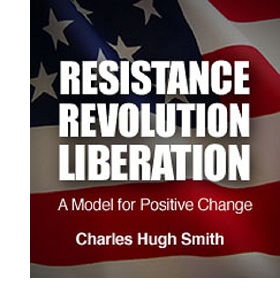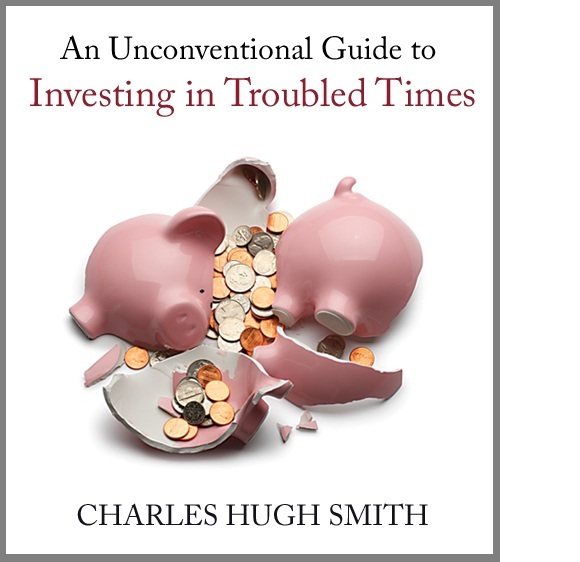

|

|
|||||||||||||
|
If You Prop Up an Artificial Economy Long Enough, Does It Become Real? (October 2, 2012) Does carefully nurturing a facade of health actually lead to health? No; all it does is perpetuate a destructive illusion. The policy of the Status Quo since 2008 boils down to this assumption: if we prop up an artificial economy long enough, it will magically become real. This is an extraordinary assumption: that the process of artifice will result in artifice becoming real. This is the equivalent of a dysfunctional family presenting an artificial facade of happiness to the external world and expecting that fraud to conjure up real happiness. We all know it doesn't work that way; rather, the dysfunctional family that expends its resources supporting a phony facade is living a lie that only increases its instability. The U.S. economy is artificial in three important ways: 1. The Federal Reserve has distorted the market for borrowing capital by reducing interest rates to zero. Those holding capital (savings) receive essentially zero interest income while favored borrowers (banks and large corporations) can pursue marginal-return speculations for free (when measured in real terms), creating systemic moral hazard of the most pernicious sort. 2. The Federal Reserve's monetizing of Federal borrowing via the purchase of Treasury bonds has given the government a "free" hand to spend $1.3 trillion more than it collects in tax revenues, feeding inflation (The Source of High Inflation: Government Spending) and the moral hazard created by having essentially free money to dispense to cronies and to buy voter complicity. In a real market economy, the cost of Federal borrowing would rise as bondholders would demand a premium for taking on the risk that interest rates would eventually rise under the relentless accumulation of stupendous debt. That mechanism has been frozen by the Fed's monetiziation of Federal borrowing. 3. The housing market has essentially been socialized, with the taxpayers now funding the entire mortgage market (98% of mortgages are backed by Federal agencies) and endless subsidies of marginal buyers (3% down payment loans, etc.) The Federal Reserve has committed itself to taking trillions of dollars of impaired or dodgy mortgages off the balance sheets of banks and burying them in its own opaque balance sheet, while also maintaining near-zero interest rates (when adjusted for inflation) to incentivize refinancing and home buying--both of which generate billions of dollars in fat fees for banks. All this artifice has created an artificial economy on multiple levels. The entire bond market is artificial, the entire stock market is artificial, and the entire housing market is artificial. One of the more striking quotes I've read recently was buried in a report chronicling the effects of the housing bust on Nevada. The quote was by a woman who had stopped paying her mortgage three years ago and had been living rent/mortgage-free in the house courtesy of the bank, which had declined to even begin the foreclosure process. Harris, 38, stopped paying her mortgage three years ago after her accounting business lost its biggest client and her home’s value plummeted 52 percent. Some neighbors are also delinquent on their mortgages. “There are so many people like me who aren’t paying their mortgage so they can buy groceries and gas,” said Harris, who was rejected for loan modification programs. “It’s creating this whole false economy.” This is an astonishing statement on several levels. That people can only afford to keep afloat if their housing is free reflects an extreme of financial fragility. That the banks are willing to pay property taxes and receive zero income for 3+ years reflects the banks' dedication to restricting the inventory of unsold homes so prices will be forced higher as supply drops below demand. This strategy, no doubt orchestrated with quasi-official approval, has already paid handsome dividends, as beaten-down markets such as Phoenix have seen sharp increases in home values this year as the number of foreclosed homes entering the market has dwindled. This artificial restriction of inventory by lenders has been well-documented; not only are there millions of homes in the foreclosure pipeline that are not being moved onto the marketplace, there are at least (by some estimates) another 4 million in-default homes that are being held out of the pipeline entirely; this is the "shadow inventory," the inventory that is not even recognized as being in default despite 3+ years of non-payment. This is a risky game the banks are playing, as this visibly artificial restriction of inventory undermines the belief that this recent surge in home valuations is legitimate, i.e. a balancing of actual supply and demand. Sqeezing inventory does not magically enlarge the pool of qualified home buyers; it "games the system" so those buyers are paying more for the homes that they would otherwise be worth if the market weren't being manipulated. This helps banks by raising the prices they're getting for the few foreclosed properties that reach the market, but it certainly doesn't help buyers. This strategy is betting that the gains reaped by selling REOs ("real estate owned," i.e. houses the banks own) at higher prices more than offset the losses generated by paying the costs of non-performing loans--property taxes, for example--and the decline in income as homeowners stop making mortage payments. The real estate industry and the banks are hoping that the increase in housing prices caused by the restriction of inventory will spark a new rush into real estate as people start believing "the bottom is in." But this is based on the expectation that there is pool of potential buyers who are only waiting for the bottom to be identified to jump in and buy a house. The irony is that restricting inventory keeps prices high, limiting the number of people who qualify for large mortages. Given that incomes of the lower 95% of households have been declining for four years, the foundation of borrowing is crumbling. The Fed has attempted to increase leverage by lowering mortgage rates to 3.5%, barely above official inflation, while relieving banks of impaired mortgages by buying $1 trillion of mortgage-backed securities in 2009-10 and now another $500 billion over the next year. The idea here is that maintaining an artificial market and reality will somehow magically transform a broken system into a self-healing one. Stated in this transparent fashion, the absurdity of the Status Quo's primary policy is clearly revealed. Dysfunctional families, enterprises, markets and governing Elites all share this same dilemma: you cannot fix an unhealthy, dysfunctional system by hiding reality behind an artificial reality facade. All you're doing is increasing the instability of the system, which is not allowed to self-correct. The U.S. economy is riddled with artifice: millions of people who recently generated income from their labor have gamed the system and are now "disabled for life." Millions more are living in a bank-enabled fantasy of free housing. Millions more are living off borrowed money: student loans, money the government has borrowed and dispensed as transfer payments, etc. Assets are artificially propped up lest a banking sector with insufficient collateral be revealed as structurally insolvent. One definition of dysfunction is an internal conflict that cannot be resolved. That is our Status Quo: its strategy to fix its dysfunction and instability is to create an artificial economy based on smoke-and-mirrors data, ginned up balance sheets and a facade of "normalcy" that is anything but normal or healthy. How can such an artificial economy become healthy when its self-correcting features and transparency have both been overriden by artifice?
It's not difficult to predict an eventual spike of instability in such a system; the
only difficulty is predicting the date of the instability. Hiding a broken, dysfunctional
economy behind a facade of artifice and illusion can't fix what's broken, it only
adds to the system's systemic instability as resources that could have gone to actually
fix things are squandered on propping up phony facades of "growth" and "health."
 Resistance, Revolution, Liberation: A Model for Positive Change
(print $25)
Resistance, Revolution, Liberation: A Model for Positive Change
(print $25)
(Kindle eBook $9.95) Read the Introduction (2,600 words) and Chapter One (7,600 words) for free.
We are like passengers on the Titanic ten minutes after its fatal encounter with the iceberg: though our financial system seems unsinkable, its reliance on debt and financialization has already doomed it.

If this recession strikes you as different from previous downturns, you might
be interested in my book
An Unconventional Guide to Investing in Troubled Times (print edition)
or
Kindle ebook format. You can read the ebook on any
computer, smart phone, iPad, etc. Click here for links to Kindle apps and Chapter One.
The solution in one word: Localism.
Of Two Minds Kindle edition: Of Two Minds blog-Kindle

"This guy is THE leading visionary on reality.
He routinely discusses things which no one else has talked about, yet,
turn out to be quite relevant months later."
NOTE: gifts/contributions are acknowledged in the order received. Your name and email remain confidential and will not be given to any other individual, company or agency.
Or send him coins, stamps or quatloos via mail--please request P.O. Box address. Subscribers ($5/mo) and contributors of $50 or more this year will receive a weekly email of exclusive (though not necessarily coherent) musings and amusings. At readers' request, there is also a $10/month option. What subscribers are saying about the Musings (Musings samples here): The "unsubscribe" link is for when you find the usual drivel here insufferable.
All content, HTML coding, format design, design elements and images copyright © 2012 Charles Hugh Smith, All rights reserved in all media, unless otherwise credited or noted. I would be honored if you linked this essay to your site, or printed a copy for your own use.
Terms of Service:
|
Add oftwominds.com to your reader:
My Big Island Girl
Instrumentals by my friend
|
| Survival+ | blog fiction/novels articles my hidden history books/films what's for dinner | home email me | ||